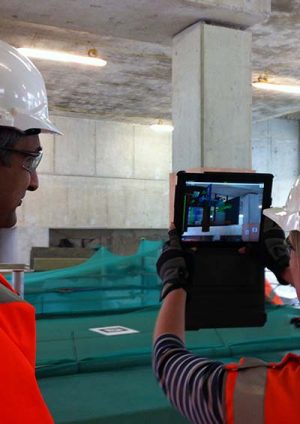The concept of using an electric display that overlays data onto real life was first mention in 1901 by Author L Frank Baum. It was not until 1990 until the term ‘Augmented Reality’ was coined by Thomas P. Caudell from Boeing. Augmented reality (AR) is defined as a live direct or indirect view of a physical, real-world environment whose elements are augmented (or supplemented) by virtual computer-generated sensory input such as sound, video, graphics or GPS data.
The “Sword of Damocles” head-mounted display was the original augmented reality headset, circa 1968. Within Construction the idea of using AR to aid with visualising building projects is not a new concept. Using computer generated images of a structure superimposed into the real life intended location was demonstrated by Trimble back in 2004. Gartner recognising AR as an emerging technology on their famous Technology Hype Cycle a year later in 2005 however since this early promise AR has been stuck in the “Trough of Disillusionment” since 2012. Gartner still predicts that the technology is 5-10 years from mainstream adoption and if Construction is a trailing industry it could take even longer before it truly revolutionises our construction sites.
So why has the technology failed to become more than a gimmick, only finding its way into the hands of fighter pilots and military special forces? With Google famously failing to get AR to the masses through its Google Glass project what does this mean to its future potential for adoption within the Construction industry?
This paper will outline the current landscape of AR technology and will argue that the blockers holding back adoption of the technology are quickly eroding. Outline lessons learnt from trial implementations by Bechtel Infrastructure and Crossrail the paper will also identify use cases for the Construction industry which hold the promise for improved productivity and health & safety on site.

